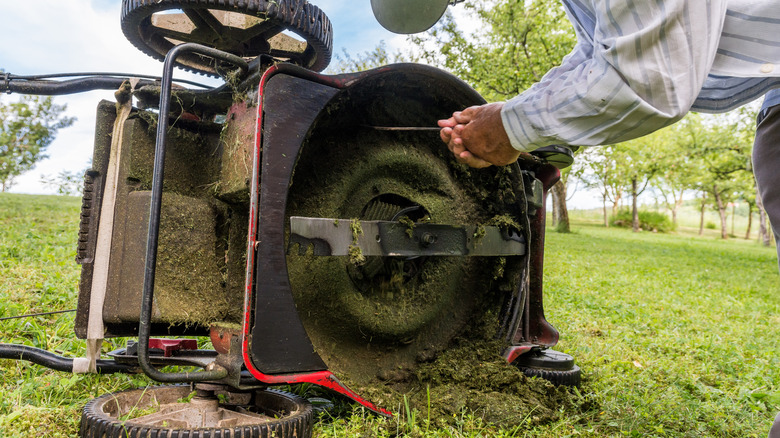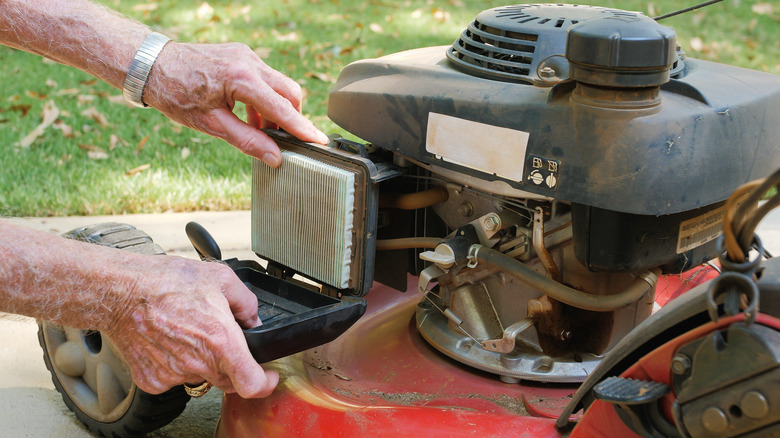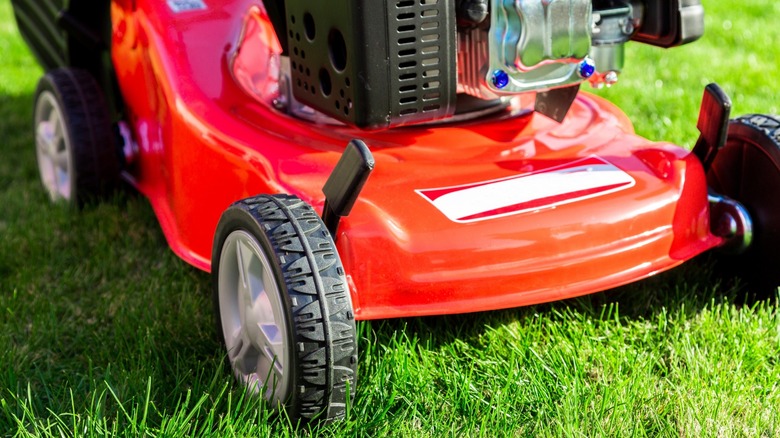How To Clean Your Lawn Mower From Top To Bottom
Do you take your lawn mower for granted? Have you ever cleaned it from top to bottom? If not, it's probably the perfect time to make up for it, as maintaining your lawn mower is essential for its longevity and performance. Cleaning in the late fall is a great way to prepare your lawn mower for winter, but you should clean it whenever it's needed. Before we begin, remove the bag and gather your tools. You'll need a garden hose, a wrench, a putty knife, a wire brush, oil lubricant, a rag, and protective gear.
The first step is cleaning the mower deck. Move your lawn mower to a flat paved surface, turn the engine off, and ensure all moving parts have stopped. If you have a hose port, set your cutting height to the lowest setting and connect your garden hose. Run the water and start your engine; continue until no more clippings are running down from the underside. Shut off the water, disconnect the hose, and restart the engine. Let the mower run for a few minutes to dry the underside before shutting it off again.
For those without a hose port and gas-powered mower, ensure the spark plug is disconnected to prevent accidental starting. Then, empty your fuel tank to avoid spills or water contamination. If it's electric-powered, unplug it from any electrical outlet. Next, tilt the mower (carburetor side up) and remove the blade, using a wrench to loosen the bolt. With the blade off, scrape away accumulated grass from the mower deck's underside with a putty knife and gently rinse with the hose, Wipe off any remaining debris with a rag.
Step-by-step lawn mower cleaning
After the deck, focus on the blade and inspect it for wear or damage. Following this, use a wire brush to remove rust and clippings. A sharp blade is crucial for an efficient cut, so consider sharpening or replacing it if necessary. Most lawn care experts recommend twice a season, or if you notice the mower is no longer cutting the grass well. Another important inspection point is the air filter. The best method for cleaning your lawn mower air filter depends on the type of filter you have. Paper filters should be tapped out or replaced if dirty, while foam filters can be washed, rinsed, and dried. This step ensures your mower breathes easily, maintains performance, and prevents engine strain.
Bring your attention to the spark plug and then the battery. First, remove the spark plug using a wrench and inspect it for buildup, corrosion, or cracks. If damaged, replace it with one that matches your mower's correct engine model. If not, clean it with a rag or brush as needed. Now, put it back to ensure an easy starting. For mowers equipped with a battery, remove any electrical connections and carefully clean the terminals by applying an electrical contact cleaner like WD-40. With your rag or wire brush, remove any dirt or corrosion, as this will increase the reliability of your mower and prevent any misfires.
Next, you'll want to look for the owner's manual for specific lubrication points and recommended products. Apply lubricant sparingly to moving parts like wheels, axles, and pivot points. This will ward off rust and give you a well-oiled machine.
Post-cleaning checklist
At the end of your lawn mower's cleaning process, start by reassembling and securely tightening any removed components, including the air filter, blade, screws, and bolts. This step is a rewarding one as you get to wash the exterior and make it shine. Refrain from using a hose as it can damage sensitive areas like the air filter and spark plug housing due to water intrusion. Opt for a bucket of soapy water and a cloth, and gently wipe down the mower's body, avoiding direct contact with the engine or electrical components. Dry the mower with a clean cloth to prevent water spots and corrosion.
That's it. Depending on your perspective, you've successfully cleaned your lawn mower from top to bottom or bottom to top. Finally, it's time to perform a test run and hear your lawn mower thank you with that clean engine purr. Refill the fuel tank and start it up. This step verifies that everything has been correctly reassembled and the mower is functioning as expected.
Maintaining your lawn mower's peak condition requires a routine encompassing cleaning, blade maintenance, and engine or filter inspection. While it might appear overwhelming at first, the benefits of such diligence are undeniable. Such practices extend the life of your lawn mower, saving you time and money on future repairs, and contribute to your lawn's overall health and appearance. By following these steps, you'll keep your lawn looking its best, making it a source of pride and enjoyment.


